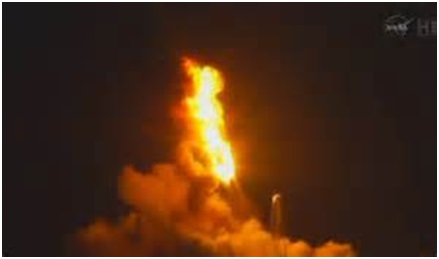Since the U.S. cancelled the Space Shuttle program in 2011, it has had to rely on foreign governments and private companies to ferry supplies to the International Space Station. One of the company contracted for this job is Orbital Sciences (OS). On October 28, 2014 they attempted to launch a Cygnus cargo spacecraft with five thousand pounds of cargo atop an Antares rocket from the NASA Wallops Island Flight Facility in Virginia. There were also some experiments designed by high school students included in the rocket’s load. Something blew out the side of the engine module on the rocket just as it was lifting off, then the rocket stopped climbing and settled back to the pad where it exploded in a huge ball of fire. The video of the explosion was quite dramatic. Fortunately, the rocket was unmanned but vital supplies for the Space Station were lost.
It took several days for the authorities to determine what had caused the rocket to explode. They believe that the rocket’s turbopump blew up and the ground crew triggered the rocket’s self-destruct system as it fell back to the launch pad. The turbopump was part the AJ26 engine which was based on the design of an old NK-33 Soviet rocket engine that had been developed in the 1970s. The engine design had been modified to incorporate steerable nozzles. OS had successfully launched two cargo missions to the Space Station earlier this year using the same type of engine. OS says that it will fast track the replacement of the old Soviet engines with newer models.
There have been concerns raised about NASA subcontracting spacecraft from private companies to supply the Space Station. One major problem is the tendency of corporations to cut costs where ever possible. Utilizing Soviet space technology from the 1970s would seem to qualify. However, as is often the case, cutting costs can result in the use of inferior components that may fail such as the turbopump in the Antares rocket. In spite of the setback for OS and the damage to the Wallops Island launch pad, OS has just been awarded a one hundred eighty six million dollar contract from NASA for their balloon program. NASA says that they have complete confidence in OS.
The next launch by OS may be delayed for more than a year because of the accident. SpaceX, another private company just got a contract to deliver supplies to the Space Station with its Falcon 9 rocket equipped with Merlin engines. Both the rocket and its engines were designed by SpaceX.
Members of Congress have been critical of the use of Soviet rocket engine designs and have demanded that the U.S. become more independent of the need for purchasing space technology from foreign sources. The U.S. House of Representative recently passes a National Defense Authorization Act which included two hundred and twenty million dollars to develop U.S. alternatives to Russian space technology, including engines.
The Antares rocket as it crashes back to the launch pad:
